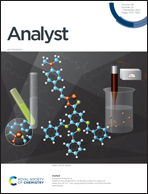Quantitative analysis of binary and ternary organo-mineral solid dispersions by Raman spectroscopy for robotic planetary exploration missions on Mars†
Abstract
The Mars 2020 and ExoMars 2022, rover-based missions are specifically dedicated to the search for evidence of life and will both utilise Raman spectrometers on the surface of Mars. Raman spectroscopy is indeed a valuable analytical technique for planetary exploration that enables in situ characterisation of rocks and soils collected directly from the surface or retrieved as cores and subsequently crushed when extracted from the subsurface with a drill. On Mars, the miniaturised spectrometers will interrogate ancient geological deposits, in order to try and identify hydrated or aqueously altered minerals and organic matter to assess the habitability of Mars. While the identification of relevant hydrous minerals and organic components is the primary analytical objective of the missions, quantifying their abundances would be of particular significance for interpreting past geological conditions (e.g. formation or alteration processes) and for ascertaining the putative presence of biosignatures. Therefore, we have developed quantitative models that enable the quantification of both mineral proportions from crushed mixtures of geological components and spiked mixtures containing organic analytes dispersed in mineral matrices. Based on data normalisation with appropriate standards (internal and external), we demonstrate that robust quantitative models can be (1) applied for solid dispersions of various complexities relevant to planetary exploration; and (2) applied to different Raman set-ups, including an instrument representative of the ExoMars Raman Laser Spectrometer. With important Raman-active minerals (calcite, gypsum, baryte, quartz), we demonstrate that using a correction factor Fϕ2/ϕ1, based on the ratio of apparent Raman scattering coefficients, the relative proportion of minerals in binary mixtures can be accurately determined. Regarding the organics, evaluated in clay-rich sediments (Fe-smectite) and crushed rocks of coarse-grained fraction (>100μm), we establish calibration curves in the concentration range 2–20 wt% for non-resonant compounds (L-cysteine, phthalic acid, adenine) and even lower (<1 wt%) for pre-resonant anthracene. Despite large levels of heterogeneity, the Raman analyses of these solid dispersions verify that quantitative Raman analyses can be performed in the context of robotic exploration studies.



 Please wait while we load your content...
Please wait while we load your content...